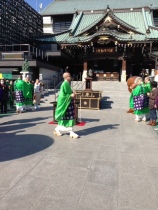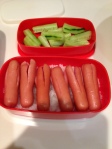 Just this week the 2015 Michelin Guide came out and The Japan Times reports that Tokyo has retained its spot as the best city in the world in which to eat. But back in September, Marc and I celebrated our 20th wedding anniversary, and in lieu of presents, we decided to go experiential, and we made reservations at a restaurant called Kanda. In the new guide, Kanda is listed as #4 on the list of the twelve best restaurants in Tokyo. It deserves the rank; it was a food experience like no other I’ve had.
Just this week the 2015 Michelin Guide came out and The Japan Times reports that Tokyo has retained its spot as the best city in the world in which to eat. But back in September, Marc and I celebrated our 20th wedding anniversary, and in lieu of presents, we decided to go experiential, and we made reservations at a restaurant called Kanda. In the new guide, Kanda is listed as #4 on the list of the twelve best restaurants in Tokyo. It deserves the rank; it was a food experience like no other I’ve had.
Kanda is located in Moto Azabu just off TV Asahi Dori, near the fire station, if you know Tokyo. It is on the  bottom floor of an apartment building and the sign is out of the way and very unobtrusive. It is only in Japanese. If you were not looking for it, you’d never find it. I did not take photos of the sign, the door or the restaurant in general because they only allow pictures of the actual food. The restaurant is small and spare, but elegantly decorated. There is one table in a side room behind a curtain that seats about eight, but the main dining room consists of twelve seats at a bar. It is done in light wood with bamboo-backed chairs. The walls have a few small paintings and Japanese sayings in Kanji adorning them, but otherwise the focus really is meant to be on the food, not the place itself.
bottom floor of an apartment building and the sign is out of the way and very unobtrusive. It is only in Japanese. If you were not looking for it, you’d never find it. I did not take photos of the sign, the door or the restaurant in general because they only allow pictures of the actual food. The restaurant is small and spare, but elegantly decorated. There is one table in a side room behind a curtain that seats about eight, but the main dining room consists of twelve seats at a bar. It is done in light wood with bamboo-backed chairs. The walls have a few small paintings and Japanese sayings in Kanji adorning them, but otherwise the focus really is meant to be on the food, not the place itself.
But what food it is! We had a total of eleven courses. Remember, each course in Japan is small, a few bites at most. As is common, we chose the middle course menu and we picked it ahead of time when we made the reservation. The only menu we ever saw was for drinks, and even that was small in number.
Since we were truly celebrating, we started with a glass of champagne, but that and a small bowl of sake were our only drinks. We felt it was too important to focus on the taste of the food and did not want alcohol to dull our senses.
Here are the 11 courses:
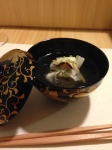
Soup with a dumpling made of yuba – skin of the bean curd – with decadent matsutake mushrooms, available only in September and October.

Suzuki fish grilled, but then only the top is gently fried for a mix of textures that melt in your mouth. Surrounded by ginko beans and rinkon – lotus root.

The most precious, delicious and succulent piece of Japanese beef we have every had or may ever have again.
This was truly the meal of a lifetime – so far at least! It was pricey for sure, but worth every yen for the experience of it.


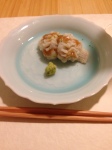

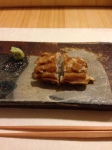



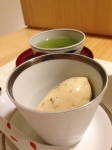


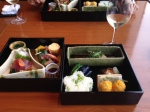


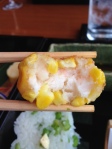


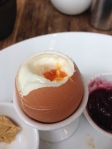


 led Chabara that seems to have every Japanese food curiosity in the country. It even has a sake tasting table and all different types of sauces and tsukemono, pickles. Of course what fascinated us was the tasting bar for the flavored nut snacks – they came in 20 different flavors, from honey to wasabi to cherry and we tried many of them.
led Chabara that seems to have every Japanese food curiosity in the country. It even has a sake tasting table and all different types of sauces and tsukemono, pickles. Of course what fascinated us was the tasting bar for the flavored nut snacks – they came in 20 different flavors, from honey to wasabi to cherry and we tried many of them.




 arrangements, gilt elevators and omnipresent staff. The elevators themselves are perfectly modern but they have beautful touches of bygone eras. Chief among those touches is the concept of the elevator girl. She is immaculately dressed in a uniform complete with the pillbox hat. She has to manually close the bars before the official elevator door will close. She uses a lever to stop and start the elevator. She steps out on the floors to announce where the elevator is and where it is headed, along with what is located on that particular floor. It is truly a gorgeous throwback and a sight to behold. I highly recommend a trip to Takashimaya’s flagship store in Nihonbashi – go ride the elevator.
arrangements, gilt elevators and omnipresent staff. The elevators themselves are perfectly modern but they have beautful touches of bygone eras. Chief among those touches is the concept of the elevator girl. She is immaculately dressed in a uniform complete with the pillbox hat. She has to manually close the bars before the official elevator door will close. She uses a lever to stop and start the elevator. She steps out on the floors to announce where the elevator is and where it is headed, along with what is located on that particular floor. It is truly a gorgeous throwback and a sight to behold. I highly recommend a trip to Takashimaya’s flagship store in Nihonbashi – go ride the elevator.
